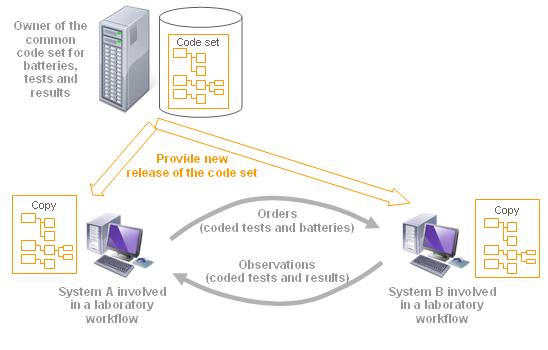Laboratory Code Sets Distribution
| This profile is part of the Pathology and Laboratory Medicine (PaLM) domain, which merged the former AP and LAB domains since 2016, January 4th. |
Laboratory Code Sets Distribution (LCSD) shares common nomenclatures among systems involved in laboratory workflows.
Summary
A set of common codes is generally used by multiple application systems in a laboratory workflow environment. These common codes need to be synchronized across the various applications at a given site. In many implementations, one application system will be the owner (the "master") of the code set. The responsibility for managing a code set may also be distributed among different systems. This profile provides a way for the master of a code set (battery, test and observation codes) to send the code set to other applications.

Benefits
Establishes and maintains a common vocabulary between systems involved in laboratories workflows
- Sharing of common nomenclatures between the systems.
- Spreading of new releases, to keep all systems up-to-date with the nomenclature.
Details
Use case:
- The system owning a laboratory code set - the Code Set Master Actor - sends the whole code set to any Code Set Consumer Actor, each time an update on this code set is needed. The update is sent as a new release, the release number being indicated in the header of the messages.
Transactions:
The LCSD Integration Profile defines a single Transaction called LAB-51. This transaction is based on HL7 release 2.5 or 2.5.1 messaging standard, namely the "master file notification" messages "MFN":
- LAB-51 Laboratory Code Set Management. This transaction provides the set of MFN messages that enable to replace wholy the current version of a code set with a new version:
- MFN^M08: Tests producing numeric results. In addition, this message can carry the units of measure, te range of decimal precision and the reference range.
- MFN^M09: Tests producing categorical observations. In addition, this message can carry the list of valid answers (coded or textual) for each test. It also carries the preferred coding system used.
- MFN^M11: Tests producing calculated observations. In addition, this message can carry the derivation rule, which will produce the observations.
- MFN^M10: Batteries or panels. This message carries the batteries, their chararacteristics and the list of tests they are composed of.
Systems Affected
Systems involved in this profile can be any of the systems involved in the workflow profiles of the Laboratory Technical Framework (LTW, LPOCT, LDA, LBL). One system plays the role of the Code Set Master and another system plays the role of the Code Set Consumer
Actors & Transactions:
Specification
Profile Status: Final Text
Documents: IHE Laboratory Technical Framework:
Underlying Standards:
See Also
Related Profiles
The Integration Profile LCSD can be leveraged by any of the workflow profiles of the Laboratory Technical Framework, that is: LTW, LDA, LPOCT, LBL
Consumer Information
This page is based on the Profile Template